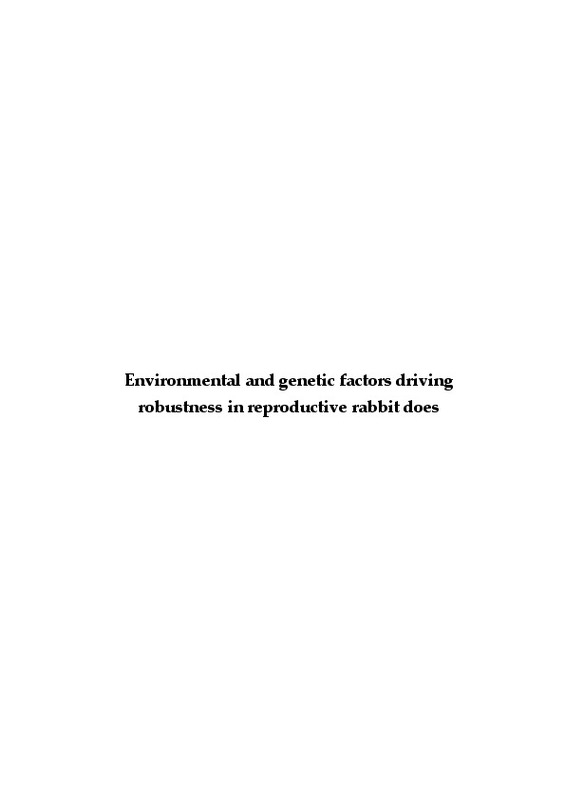- RiuNet repositorio UPV
- :
- Investigación
- :
- Tesis doctorales
- :
- Ver ítem
JavaScript is disabled for your browser. Some features of this site may not work without it.
Buscar en RiuNet
Listar
Mi cuenta
Estadísticas
Ayuda RiuNet
Admin. UPV
Environmental and genetic factors driving robustness in reproductive rabbit does
Mostrar el registro sencillo del ítem
Ficheros en el ítem
| dc.contributor.advisor | Friggens, Nicholas Charles
|
es_ES |
| dc.contributor.advisor | Pascual Amorós, Juan José
|
es_ES |
| dc.contributor.author | Savietto, Davi
|
es_ES |
| dc.date.accessioned | 2014-04-30T10:21:11Z | |
| dc.date.available | 2014-04-30T10:21:11Z | |
| dc.date.created | 2014-04-11T09:00:44Z | es_ES |
| dc.date.issued | 2014-04-30T10:21:09Z | es_ES |
| dc.identifier.uri | http://hdl.handle.net/10251/37198 | |
| dc.description.abstract | Selection strategies to increase productive traits of farm animals have been effective and highly specialized breeds and strains were obtained. At the same time, the effort made to obtain extremely high producing animals was accompanied by undesired effects, such as a reduced ability to sustain production, reproduction and health; especially under constrained conditions. The perception that selection was degrading robustness, lead to selection strategies aiming to improve the ability of animals to perform in a wider range of environmental constrain. However, at the present moment, the physiological mechanisms allowing farm animals to perform well in a wide range of environments, while others succumb, have not been described. The present thesis intended to address this question by describing the evolution of traits related to fitness, survival and to the adaptability to environmental constraints. Two maternal rabbit lines differing in their ability to face the environmental constraints, i.e. a `specialist¿ and a `generalist¿ maternal rabbit line were available. Additionally, two generations (20 generations apart) of the specialized line were simultaneously available. During the first two consecutive reproductive cycles, female rabbits were simultaneously subjected to three environmental conditions differing in the intensity and in the physiological constrain imposed. Digestive capacity, the acquisition of resources and the partitioning of resources into different function (i.e. litter size, milk yield, growth, body reserves, etc.) was also assessed. Results showed a greater acquisition capacity of `generalist¿ females in constrained conditions with respect to `specialist¿ females. Moreover, the greater acquisition capacity was not accompanied by a reduction in the digestive efficiency, allowing the `generalist¿ females a relative greater acquisition of digestible energy. The maintenance of reproductive performance by having a greater acquisition capacity, together with the avoidance of making an intensive use of body reserves were both related to the capacity of `generalist¿ females to sustain reproduction in a wide range of environmental conditions. Twenty generations of selection exclusively for reproduction (specialized line), was not accompanied by a higher acquisition capacity, but by a change in the relative priority between the litter being nursed (actual) and the litter being gestate (future litter). In this sense, females from the actual generation of selection for litter size at weaning had a greater milk yield in the first week of lactation (period of great importance to kits survival), reducing it by the end of lactation. The present thesis also evidenced the importance of the environment where the animals are being selected in the evolution of the interplay between competing functions. | en_EN |
| dc.language | Inglés | es_ES |
| dc.publisher | Universitat Politècnica de València | es_ES |
| dc.rights | Reserva de todos los derechos | es_ES |
| dc.source | Riunet | es_ES |
| dc.subject | Rabbit Females | es_ES |
| dc.subject | Selection | es_ES |
| dc.subject | Longevity | es_ES |
| dc.subject | Litter Size | es_ES |
| dc.subject | Robustness | es_ES |
| dc.subject | Resources Allocatio | es_ES |
| dc.subject.classification | NUTRICION Y BROMATOLOGIA | es_ES |
| dc.subject.classification | PRODUCCION ANIMAL | es_ES |
| dc.title | Environmental and genetic factors driving robustness in reproductive rabbit does | |
| dc.type | Tesis doctoral | es_ES |
| dc.identifier.doi | 10.4995/Thesis/10251/37198 | es_ES |
| dc.rights.accessRights | Abierto | es_ES |
| dc.contributor.affiliation | Universitat Politècnica de València. Departamento de Ciencia Animal - Departament de Ciència Animal | es_ES |
| dc.description.bibliographicCitation | Savietto, D. (2014). Environmental and genetic factors driving robustness in reproductive rabbit does [Tesis doctoral]. Universitat Politècnica de València. https://doi.org/10.4995/Thesis/10251/37198 | es_ES |
| dc.description.accrualMethod | TESIS | es_ES |
| dc.type.version | info:eu-repo/semantics/acceptedVersion | es_ES |
| dc.relation.tesis | 8047 | es_ES |
| dc.description.award | Premios Extraordinarios de tesis doctorales | es_ES |
Este ítem aparece en la(s) siguiente(s) colección(ones)
-
Tesis doctorales [5389]







![MS Word file [Word]](/themes/UPV/images/msword.png)

